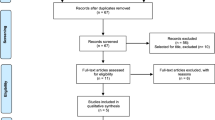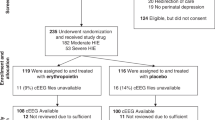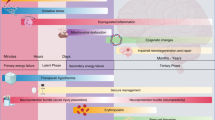Abstract
Objective:
Erythropoietin (EPO) is neuroprotective after asphyxia in animal studies. The efficacy and safety of EPO monotherapy in term neonates with hypoxic ischemic encephalopathy (HIE) is uncertain.
Study Design:
Hundred term neonates with moderate or severe HIE were randomized by random permuted block algorithm to receive either EPO 500 U kg−1 per dose in 2 ml saline intravenously (50 neonates) on alternate days for a total of five doses with the first dose given by 6 h of age (treatment group) or 2 ml of normal saline (50 neonates) similarly for a total of five doses (placebo group) in a double-blind study. No hypothermia was given. The primary outcome was combined end point of death or moderate or severe disability at mean age of 19 months (s.d., 0.61).
Results:
Death or moderate or severe disability occurred in 40% of neonates in the treatment group vs 70% in the placebo group (risk ratio, 0.57; 95% confidence interval (CI) 0.38 to 0.85; P=0.003). Death occurred in 16% of patients in both the groups (risk ratio, 1.0; 95% CI 0.33 to 2.9; P=0.61). The risk of cerebral palsy was lower among survivors in the treatment group (risk ratio, 0.52; 95% CI 0.25 to 1.03; P=0.04) and lesser number of babies were on anticonvulsants at assessment (risk ratio, 0.47; 95% CI 0.20 to 1.01; P=0.03). Neonatal brain magnetic resonance imaging showed more abnormalities in the placebo group (relative risk, 0.66; 95% CI 0.42 to 1.03; P=0.04)). Improvement in other neurological outcomes was not significant.
Conclusion:
EPO monotherapy reduces the risk of death or disability in term neonates with moderate or severe encephalopathy.
This is a preview of subscription content, access via your institution
Access options
Subscribe to this journal
Receive 12 print issues and online access
$259.00 per year
only $21.58 per issue
Buy this article
- Purchase on Springer Link
- Instant access to full article PDF
Prices may be subject to local taxes which are calculated during checkout
Similar content being viewed by others
References
Shankaran S, Woldt E, Koepke T, Bedard MP, Nandayal R . Acute neonatal morbidity and long-term central nervous system sequelae of perinatal asphyxia in term infants. Early Hum Dev 1991; 25: 135–148.
Robertson CMT, Finer NN, Grace MGA . School performance of survivors of neonatal encephalopathy associated with birth asphyxia at term. J Pediatr 1989; 114: 753–760.
Busto R, Dietrich WD, Globus MYT, Valdes I, Scheinberg P, Ginsberg MD . Small differences in intraischemic brain temperature critically determine the extent of ischemic neuronal injury. J Cereb Blood Flow Metab 1987; 7: 729–738.
Shankaran S, Laptook AR, Ehrenkranz RA, Tyson JE, McDonald SA, Donovan EF et al. Whole-body hypothermia for neonates with hypoxic-ischemic encephalopathy. N Engl J Med 2005; 353: 1574–1584.
Jacobs SE, Morley CJ, Inder TE, Stewart MJ, Smith KR, McNamara PJ . Whole body hypothermia for term and near term newborns with hypoxic-ischemic encephalopathy: a randomized controlled trial. Arch Pediatr Adolesc Med 2011; 165: 692–700.
Edwards AD, Brocklehurst P, Gunn AJ, Halliday H, Juszczak E, Levene M et al. Neurological outcomes at 18 months of age after moderate hypothermia for perinatal hypoxic ischaemic encephalopathy: synthesis and meta-analysis of trial data. BMJ 2010; 340: c363.
Pappas A, Shankaran S, McDonald SA, Vohr BR, Hintz SR, Ehrenkranz RA et al. Cognitive outcome after neonatal encephalopathy. Pediatrics 2015; 135: e624–e638.
Azzopardi DV, Strohm B, Edwards AD, Dyet L, Halliday HL, Juszczak E et al. Moderate hypothermia to treat perinatal asphyxial encephalopathy. N Engl J Med 2009; 361: 1349–1358.
Wu YW, Gonzalez FF . Erythropoietin: a novel therapy for hypoxic-ischaemic encephalopathy? Dev Med Child Neurol 2015; 573: 34–39.
Wang L, Zhang Z, Wang Y, Zhang R, Chopp M . Treatment of stroke with erythropoietin enhances neurogenesis and angiogenesis and improves neurological function in rats. Stroke 2004; 35: 1732–1737.
Bernaudin M, Marti HH, Roussel S, Divoux D, Nouvelot A, MacKenzie ET et al. A potential role for erythropoietin in focal permanent cerebral ischemia in mice. J Cereb Blood Flow Metab 1999; 19: 643–651.
Mu D, Chang YS, Vexler ZS, Ferriero DM . Hypoxia-inducible factor 1 alpha and erythropoietin upregulation with deferoxamine salvage after neonatal stroke. Exp Neurol 2005; 195: 407–415.
Wallach I, Zhang J, Hartmann A, van Landeghem FK, Ivanova A, Klar M et al. Erythropoietin-receptor gene regulation in neuronal cells. Pediatr Res 2009; 65: 619–624.
Sugawa M, Sakurai Y, Ishikawa-Ieda Y, Suzuki H, Asou H . Effects of erythropoietin on glial cell development; oligodendrocyte maturation and astrocyte proliferation. Neurosci Res 2002; 44: 391–403.
Nagai A, Nakagawa E, Choi HB, Hatori K, Kobayashi S, Kim SU . Erythropoietin and erythropoietin receptors in human CNS neurons, astrocytes, microglia, and oligodendrocytes grown in culture. J Neuropathol Exp Neurol 2001; 60: 386–392.
Bernaudin M, Nedelec AS, Divoux D, MacKenzie ET, Petit E, Schumann-Bard P . Normobaric hypoxia induces tolerance to focal permanent cerebral ischemia in association with an increased expression of hypoxia-inducible factor-1 and its target genes, erythropoietin and VEGF, in the adult mouse brain. J Cereb Blood Flow Metab 2002; 22: 393–403.
Zhu C, Kang W, Xu F, Cheng X, Zhang Z, Jia L et al. Erythropoietin improved neurologic outcomes in newborns with hypoxic- ischemic encephalopathy. Pediatrics 2009; 124: e218–e226.
Elmahdy H, El-Mashad AR, El-Bahrawy H, El-Gohary T, El-Barbary A, Aly H . Human recombinant erythropoietin in asphyxia neonatorum: pilot trial. Pediatrics 2010; 125: e1135–e1142.
Shalak LF, Laptook AR, Velaphi SC, Perlman JM . Amplitude-integrated electroencephalography coupled with an early neurologic examination enhances prediction of term infants at risk for persistent encephalopathy. Pediatrics 2003; 111 (2): 351–357.
Thompson CM, Puterman AS, Linley LL, Hann FM, van der Elst CW, Molteno CD et al. The value of a scoring system for hypoxic ischaemic encephalopathy in predicting neurodevelopmental outcome. Acta Paediatr 1997; 86 (7): 757–761.
Palisano RJ, Hanna SE, Rosenbaum PL, Russell DJ, Walter SD, Wood EP et al. Validation of a model of gross motor function for children with cerebral palsy. Phys Ther 2000; 80: 974–985.
Bayley N Bayley Scales of Infant Development–II. Psychological Corporation: San Antonio, Texas, 1993..
Kumral A, Tüzün F, Oner MG, Genç S, Duman N, Ozkan H . Erythropoietin in neonatal brain protection: the past, the present and the future. Brain Dev 2011; 33: 632–643.
Brines ML, Ghezzi P, Keenan S, Agnello D, de Lanerolle NC, Cerami C et al. Erythropoietin crosses the blood–brain barrier to protect against experimental brain injury. Proc Natl Acad Sci USA 2000; 97: 10526–10531.
Juul SE, McPherson RJ, Farrell FX, Jolliffe L, Ness DJ, Gleason CA . Erythropoietin concentrations in cerebrospinal fluid of nonhuman primates and fetal sheep following high-dose recombinant erythropoietin. Biol Neonate 2004; 85: 138–144.
Statler PA, McPherson RJ, Bauer LA, Kellert BA, Juul SE . Pharmacokinetics of high-dose recombinant erythropoietin in plasma and brain of neonatal rats. Pediatr Res 2007; 61: 671–675.
McPherson RJ, Demers EJ, Juul SE . Safety of high-dose recombinant erythropoietin in a neonatal rat model. Neonatology 2007; 91: 36–43.
Wu YW, Bauer LA, Ballard RA, Ferriero DM, Glidden DV, Mayock DE et al. Erythropoietin for neuroprotection in neonatal encephalopathy: safety and pharmacokinetics. Pediatrics 2012; 130: 683–691.
Chang YS, Mu D, Wendland M, Sheldon RA, Vexler ZS, McQuillen PS et al. Erythropoietin improves functional and histological outcome in neonatal stroke. Pediatr Res 2005; 58: 106–111.
Ehrenreich H, Fischer B, Norra C, Schellenberger F, Stender N, Stiefel M et al. Exploring recombinant human erythropoietin in chronic progressive multiple sclerosis. Brain 2007; 130: 2577–2588.
Ehrenreich H, Hinze-Selch D, Stawicki S, Aust C, Knolle-Veentjer S, Wilms S et al. Improvement of cognitive functions in chronic schizophrenic patients by recombinant human erythropoietin. Mol Psychiatry 2007; 12: 206–220.
Ehrenreich H, Weissenborn K, Prange H, Schneider D, Weimar C, Wartenberg K et al. Recombinant human erythropoietin in the treatment of acute ischemicstroke. Stroke 2009; 40: e647–e656.
Rogers EE, Bonifacio SL, Glass HC, Juul SE, Chang T, Mayock DE et al. Erythropoietin and hypothermia for hypoxic-ischemic encephalopathy. Pediatr Neurol 2014; 51: 657–662.
El Shimi MS, Awad HA, Hassanein SM, Gad GI, Imam SS, Shaaban HA et al. Single dose recombinant erythropoietin versus moderate hypothermia for neonatal hypoxic ischemic encephalopathy in low resource settings. J Matern Fetal Neonatal Med 2014; 27: 1295–1300.
Wu YW, Mathur AM, Chang T, McKinstry RC, Mulkey SB, Mayock DE et al. High-dose erythropoietin and hypothermia for hypoxic-ischemic encephalopathy: a Phase II Trial. Pediatrics 2016; 137 (6): e20160191.
Benders MJ, van der Aa NE, Roks M, van Straaten HL, Isgum I, Viergever MA et al. Feasibility and safety of erythropoietin for neuroprotection after perinatal arterial ischemic stroke. J Pediatr 2014; 164: 481–486.
Acknowledgements
We, Dr Rahid and Dr Mushtaq, had full access to all of the data in the study and take responsibility for the integrity of the data and the accuracy of the data analysis.
Author contributions
Dr Mushtaq conceptualized and designed the study, drafted the initial manuscript and approved the final manuscript as submitted. Drs Rahid, Rouf and Manzoor carried out the initial analyses, reviewed and revised the manuscript, and approved the final manuscript as submitted. Dr Feroz coordinated and supervised data collection, critically reviewed the manuscript and approved the final manuscript as submitted.
Author information
Authors and Affiliations
Corresponding author
Ethics declarations
Competing interests
The authors declare no conflict of interest.
Rights and permissions
About this article
Cite this article
Malla, R., Asimi, R., Teli, M. et al. Erythropoietin monotherapy in perinatal asphyxia with moderate to severe encephalopathy: a randomized placebo-controlled trial. J Perinatol 37, 596–601 (2017). https://doi.org/10.1038/jp.2017.17
Received:
Revised:
Accepted:
Published:
Issue Date:
DOI: https://doi.org/10.1038/jp.2017.17
This article is cited by
-
COHESION: a core outcome set for the treatment of neonatal encephalopathy
Pediatric Research (2024)
-
Neuroprotective therapies in the NICU in term infants: present and future
Pediatric Research (2023)
-
New possibilities for neuroprotection in neonatal hypoxic-ischemic encephalopathy
European Journal of Pediatrics (2022)
-
Emerging therapies and management for neonatal encephalopathy—controversies and current approaches
Journal of Perinatology (2021)
-
Erythropoietin monotherapy for neuroprotection after neonatal encephalopathy in low-to-middle income countries: a systematic review and meta-analysis
Journal of Perinatology (2021)



